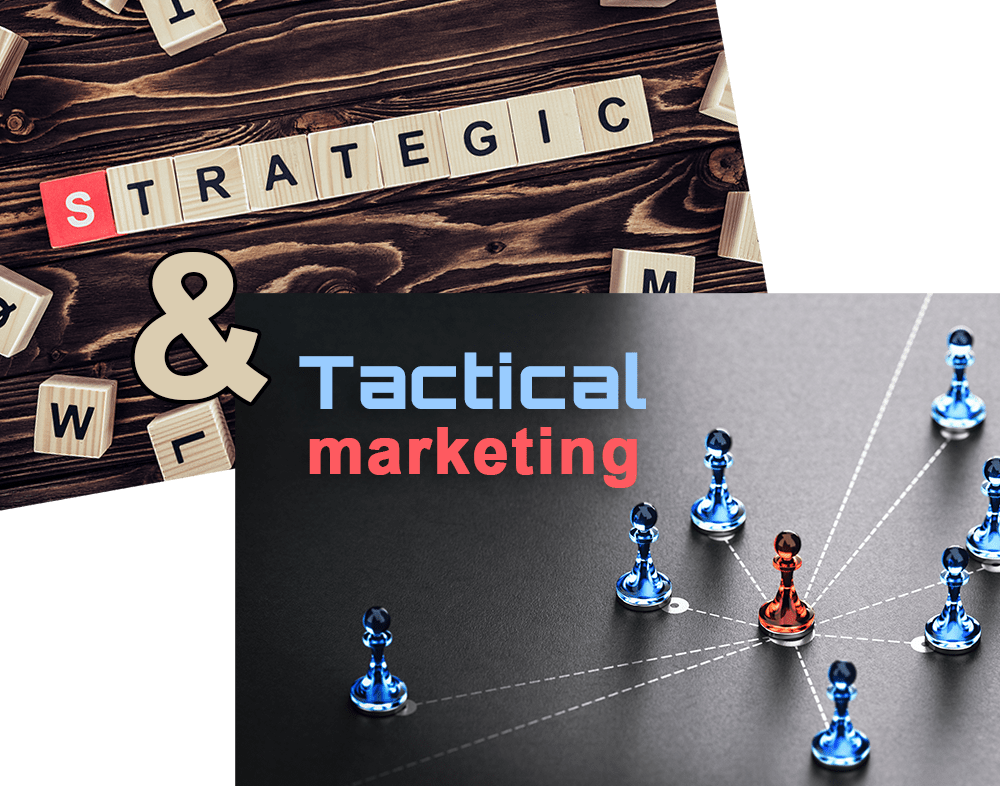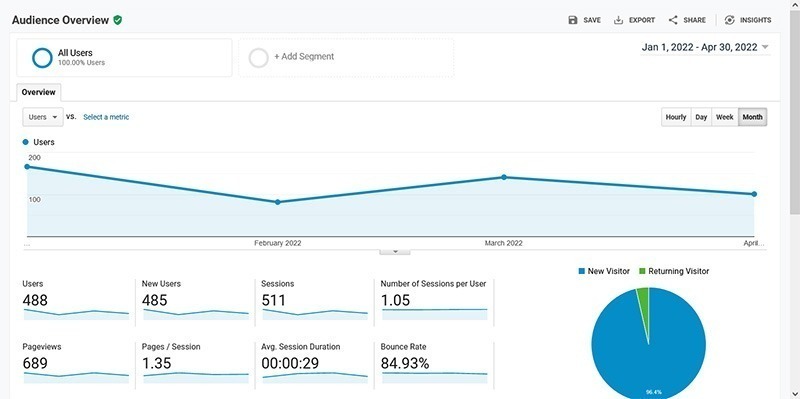There comes a time when you have to hire or outsource your marketing efforts
“We need marketing help!”
This realization happens to most young companies at some point or another. The need usually comes on all at once and is plainly obvious. Sometimes, painfully obvious. Marketing at a new or early-stage company is typically handled by the founder/president/owner until there is an event or situation that makes it clear that a change is needed. Maybe sales dropped, your messaging becomes inconsistent or poorly defined, or obvious marketing opportunities slipped by. The catalyst may be just one thing, but probably it will be a few. In any case, you will know.
Strategic vs tactical – two sides of a rapidly spinning coin
A company early in its development has to find help in each of two broad types of marketing: strategic and tactical. Yes, for both! One doesn’t exist happily without the other. Strategic marketing is the long-term, goal-oriented, overarching planning and guidance, most often including messaging and brand-building, while tactical marketing is the shorter-term, active part of marketing, such as emails, social media, blogs, outbound telemarketing, etc. To oversimplify, strategy is the thinking part, tactics is the doing part.
Why outsource your marketing?
Unless you are a well-funded startup itching to spend your VC capital on staffing, it is likely you won’t have the ability to hire (in-source) the kind of help you will need to successfully market your company, products, and services. Buying services as you need them is cheaper, particularly as you lay the groundwork for your early stage success. Most startup sales come from handshake relationships and personal connections instead of sophisticated marketing strategies and programs. The key is to make sure you have someone, either on-staff or contracted, who can adequately supervise the big picture of your marketing, reasonably art-direct the overall look and feel of your marketing materials, and maintain consistent messaging—i.e the strategy—and do the tactical with outsourced help. It’s cost-effective and easily managed. As a fractional CMO and strategy consultant, I have taken on this role many times. It is economical for clients to buy my services (or those of people like me) rather than hire me full-time. That gets pricey, and too soon in your company’s growth, it just isn’t a wise choice. (Of course, we can talk about your options. Message me here.)You should outsource your marketing when…
-
- You are starting up
- You’ve outgrown your initial marketing setup
- Sales are lagging
- Your strategies are stagnant – marketing is an ever-changing business
- You need an expert in a particular marketing method or technology
- You maxed out internal capacity for deliverables – too many hours and not enough staff
- Your internal team doesn’t have the creative resources to make materials basic to your marketing mission
Creative is marketing.
So is how you answer the telephone. And whether your restrooms are clean. Everything is marketing. But creative is even more closely tied to strategy than most people think. This is why a piecemeal approach of hiring freelancers of Fiverr (yet another blog-worthy topic in itself) can be such a train wreck for a business.Let’s discuss the 7 signs it’s time to start outsourcing your marketing a bit further.
1. You are starting up
According to Business News Daily, research tells us that “The main reason most people want to become their own boss is the freedom, satisfaction and flexibility it offers them.” Nowhere in the research is it suggested that the main reason is that they are marketing gurus!
Outsourcing marketing and creative services for start-up businesses is not only commonplace but it’s a good idea. A hallmark of a classic entrepreneurial start-up is the founder doing the lion’s share of the sales and marketing in the early stages. Startup sales efforts rely on the founder’s ability to network, the quality of the product or service, and the market’s willingness to try something new. Once there’s traction, the business of hiring more staff – including marketing – can be taken on in earnest. The sooner the better.
Most entrepreneurs are not marketers.
The successful entrepreneur is a pretty darned smart, savvy, hard-working person who is very talented in some fairly specialized area, be it software design, product development, or some service business. It’s rare that he’s also a marketing expert. An unfortunate characteristic of most entrepreneurs and many business people in general is that they feel marketing is easy and anyone can do it. Nope. That’s completely wrong!

Similarly, anyone can go on YouTube and look up Neil Patel, watch a few videos, and come out the other side thinking they’re experts in digital marketing. No! You watched a 60-minute distillation of one man’s experience with his very successful digital agency that is, by the way, staffed by dozens of talented people who are actually doing the work that Neil is talking to you about. (I am a fan, by the way. I love me some Neil Patel! The best thing about him and other sources like SEMRush and HubSpot are that they provide a ton of aggregated information in one place.)
So, entrepreneurs, you do your thing. Hire a marketer to build your brand, do your competitor analysis, and lay the groundwork for the large-scale marketing of your product. Resist the temptation to call yourself a marketer and I will not call myself a diesel mechanic. Fair?
2. You’ve outgrown your initial marketing setup
At some point or another basic marketing systems that businesses develop, often by accident, over time failed to match the current business climate. There may be too many leads coming in and no way to sort them, so a Customer Relationship Management (CRM) is needed. You may be losing customers because of a lack of post-sale communication, so you need drip campaigns in customer communications programs. Most of your incoming business may be from word of mouth or the area immediately surrounding your business location, so you need to develop your search engine presence to promote ganic Google traffic. At some point, what used to work will not work anymore and you need to re-tool, rebuild systems, and explore new methodologies. Look for help! These are critical functions, very easy for a novice to get wrong, but simple matters for marketers to get right. It can be the difference between success and failure in a post-startup, early-stage business.
3. Sales are lagging
There is no more compelling reason to improve your marketing than slumping sales! This is a no-brainer. If sales are dropping off you must do something about it as soon as possible. There are lots of reasons sales can dip, ranging from new competition to changes in the economy or your industry itself, to mistakes made by your company. Lack of sales follow-up, inability to respond quickly to changing events in the industry, or poor customer relationship management can undermine even the most successful business.

When you hire a marketing company with a sales focus to come into your business they will (well, should, anyway) undertake an initial audit of systems and people, processes, and procedures to see where they are inefficiencies, errors, and failures.
It’s hard to hear that your creation, which is a reflection of your blood, sweat, and tears, is not up to snuff. But you simply must be open to what they say. Your sales have gone down because of something that wasn’t right for whatever reason. Obviously, if it was something that you recognized on your own, you would’ve fixed it. An expert from the outside will look at the situation with a fresh pair of eyes and make suggestions to fix problems you might not even recognize.
A word of caution: if your consultant or marketing firm comes in and does not do an audit that is a red flag. Too often, companies will bring in an “expert” with a proprietary system that worked elsewhere and try to shoehorn it into an existing business. That’s not the way to make things work. Elements of successful systems can be incorporated into an existing operation, but every business is different. Systems and processes evolve over time because of physical, logistical, economic, or staffing reasons that are not magically fixed by supplanting them with a new system.
I spent the first four years of my professional career as an operations analyst, an experience that has informed my marketing work ever since. Marketing is, essentially, a system-based process, and systems require people and interactions, inputs and outputs. No one size fits all solution ever truly fits all!
4. Your strategies are stagnant
Marketing is an ever-changing business. What any of us did for marketing over the past five years will probably not work for the next five. It’s just a statistical fact. Times change, markets change, but more importantly marketing itself changes. Customer expectation is not what it once was. The Internet and cable TV have raised the standards of what consumers feel is “normal” for business. A local business, even in the smallest town in North America, cannot get away with substandard customer service and marketing methodologies when every consumer’s expectation is excellence, not mediocrity.
Bring in some outside help to suggest new ways to market your product or communicate with your customer base. Even if it’s just setting up some new protocols, systems, or processes that you can then maintain with your current staff later, it’s an investment well worth it.
5. You need an expert in a marketing method or technology
I recently worked with a company that discovered its client retention rates were horrible, sales conversion rates were even worse, and outbound marketing was anemic at best. They had recognized this on their own, however, and installed a CRM/customer communications system, ActiveCampaign, that would contribute to solving many of these problems. They had been using it for the better part of a year, but, the owner of the company said, it did not work properly.
I am a huge fan of ActiveCampaign! I have been working with it for several years with a half dozen clients and have done some high-level work with it. It features a powerful, sophisticated workflow-based automations system. Unfortunately, it has a notoriously steep learning curve and a visual interface similar to Salesforce Process Builder. Personally, I like it better than Salesforce and Zoho, but I work with all of them. (If you’d like to speak with me about ActiveCampaign marketing, email me here!)
Powerful software is pointless if it’s not used or set up correctly. My client had no internal expertise on ActiveCampaign, so their marketing automations were not optimally constructed. Worse, the program itself had never been set up correctly! Some basic steps that should be done on initial account setup were not (a strong case for reading the directions!), making client behavior tracking nearly impossible. The customer database was constructed improperly using multiple lists instead of tags, a feature that is at the heart of ActiveCampaign’s functionality. Drip campaigns were not managed in such a way that they took advantage of key customer action intelligence that the system provides. Most debilitating of all, several thousand customer records were not attached to a list, rendering them essentially lost in the system. They were ghosts in the machine.
All fixable, but it took a lot of time. It took a couple of weeks to root out and fix all the problems, find the lost customers, reconcile them to the existing customer list, and fix the software trial drip campaign. Interestingly, the process of fixing the CRM uncovered a frighteningly long list of other system errors that were responsible for lost free trial customers and lost customer data.
(I will write a case study on this project. It’s noteworthy in that the initial audit found identifiable problems but also suggested some other issues that were not so obvious. It took a lot of diffing to find the real problems, many of which lay outside of marketing and deeply inside software programming and development. What began as a fairly straightforward engagement to fix outbound messaging became a company-wide problem-solving exercise that found shortcomings in customer data management, customer service and success, PPC campaigns, sales conversions, and problems with the flagship product itself. Stay tuned for that. Better still, sign up here for our newsletter to get all of our content updates as they happen!)
6. Internal capacity for deliverables is maxed out
Too many hours and not enough staff. There is a point in many businesses where the to-do list extends well past the number of staff hours available during a week. I am referring here to truly overloaded staff not just poorly used resources. We’ve all seen examples of management that pulls staff off of their main functions to pursue other tasks. This is often necessary, but it’s usually an operational efficiency killer. Let’s assume that all staff time is going to the tasks they were originally intended to accomplish. When the marketing to-do list legitimately extends beyond the physical ability of your staff to do it then it’s time to outsource!
The counterargument to this is to cut back on the marketing functions you have outlined. I am never going to be one to tell you you’re doing too much marketing. While I have seen companies market improperly, such as too frequently to a given segment or using a particular tool, I have yet to see companies that market too much across the board. It’s a little bit like breathing too much. Don’t cut back just to see if you might be overzealous!
What ends up happening in these cases is tasks don’t get done or they get cut back in such a way that they are not effective at accomplishing the goals set out. If your social media needs to go out each day at noon but it’s getting out only Tuesday and Friday at four then there’s a problem! Outsource!
7. The internal team doesn’t have the creative resources to make adequate marketing materials
I’m circling back to creative here. Once again, marketing is creative; creative is marketing. Your social media involves creative development, as does your website, and your sales collateral, etc, etc, etc. Everything is marketing. If you have substandard, poor-quality graphics in your social media people will notice.
And this is where outsourcing is absolutely critical.
While some subscription (or even free) software or service sources suggest that you can create “professional-looking” infographics, social media, brochures, or other marketing materials using their products, I strongly suggest that that is not true. At first blush, this may sound like creative snobbery, but do you really want to make marketing materials that look professional or that truly are professional? Big difference! In reality, with those tools, you can create pieces that don’t look amateurish but that’s still setting a low bar.
Anything templated is basically a knockoff. Anyone who uses that service can have the same images and layout as you. That’s decidedly not good! To put it into an easy perspective, when people walk into your business and ask for your professional assistance, the first thing you say is most definitely not “Hi! Glad you came in! We are exactly like everyone else.” If you do, then I question your messaging.
You will find a difference in the quality level of a design piece that is created by, say, a trained graphic designer and something cobbled together from Canva. That’s not to say that Canva doesn’t make nice, pretty, useful materials. I am a trained graphic designer but I use Canva for some things and am happy with the results. But not for everything. A good graphic designer brings a lot more to the table than can a templated source no matter how high its quality might be. I’ll leave it at that.
Custom is better, almost without fail.
If you’re relying solely on Canva and are doing nothing original in your marketing creative, and your social media looks like everyone else’s, then you are doing your company a huge disservice. If it is a choice between no social media presence and one cookie-cuttered out of Canva then okay. Better to have something over nothing!The counterargument to this is to cut back on the marketing functions you have outlined. I am never going to be one to tell you you’re doing too much marketing. While I have seen companies market improperly, such as too frequently to a given segment or using a particular tool, but I have yet to see companies that market too much across the board. It’s a little bit like breathing too much. Don’t cut back just to see if you might be overzealous!
What ends up happening in these cases is tasks don’t get done or they get halftime or cut back in such a way that they are not effective at accomplishing the goals set out. If you’re social media need to go out each day at noon but it’s getting out only Tuesday and Friday at four there’s a problem! Outsource!
Look for the signs…then follow them
It is often smart business to hold off on bringing in new marketing help as your business grows. You may want to hire marketing staff early on, and that may work out well for you. I will cover just who to engage in another blog but a marketing generalist on the team early can be a good thing. When you reach the point where you see one or more of the seven signs discussed here, be ready to pull the trigger on expanding your team, be it in-house or outsourced, as soon as you can. A quick changeover from startup to running mode can be the first step toward success. References https://authenticbrand.com/marketing/when-to-hire-a-marketer/ https://news.utexas.edu/2022/05/12/reached-your-entrepreneurial-limit-hire-a-marketer-study-suggests/ https://www.businessnewsdaily.com/15186-first-startup-hires.html https://www.businessnewsdaily.com/4652-entrepreneur-motivation-benefits.html
About the author
Richard Williamson has enjoyed a three decade career in marketing, advertising, and public relations. Formally trained in graphic design and copywriting, he is a partner here at BackBurner Marketing and founder and lead designer of the Logo Design Group. Find out more about him here or at www.RichardWroteThis.com.
Richard is available for brand and marketing consulting, business coaching, and as a fractional Chief Marketing Officer.




